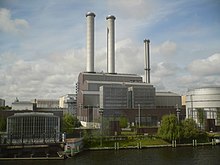Thermal power station



A heat and power plant ( CHP ) is an industrial plant for producing electricity and heat in a coupling process , the cogeneration . Due to the need to feed into a district heating network , thermal power stations are located in the vicinity of urban agglomerations or industrial plants with high heat requirements.
technology
As with a classic thermal power plant , the primary energy is usually converted into electricity with the help of a closed water-steam cycle. Heat is supplied to the water by burning fossil or biogenic fuels, whereby it evaporates in the boiler and is further brought to the highest possible temperature in the superheater . The live steam (maximum operating conditions: 520–560 ° C, 160–250 bar) is expanded in a steam turbine and drives the generator . The vapor is liquefied in a condenser . The condensed water vapor is fed to the condensate container and fed to the feed water container by means of condensate pumps . There the condensate and treated make-up water from the deionized water tank mix . The water is heated in the feed water tank and thermally degassed via the degasser dome. The container forms the template for the feed water pumps , which feed the water to the boiler - usually first via the feed water preheater .
Heating condenser
In the purely electricity-generating condensing power plant, expansion takes place down to a pressure level below 0.1 bar and partial condensation to wet steam already takes place in the turbine . The low temperature level of 30 to 40 ° C of the condensation waste heat does not allow any meaningful further use. In an original thermal power station, steam at a higher pressure is used by means of a heat exchanger (also known as a "heating condenser") in order to be able to provide energy for a district heating network. This is usually done with hot water (rarely steam). The flow temperatures are weather-compensated, from 70 ° C in summer to 140 ° C in winter.
The steam for the heating condenser can be obtained in two ways. On the one hand, a back pressure turbine can be used in which the steam is not completely expanded. After the turbine, the entire steam flow reaches the heating condenser. There is a rigid coupling relationship between the products of electricity and heat. On the other hand, an extraction condensation turbine opens up the possibility of branching off steam before entering the low-pressure part of the turbine set . More flexible operation is possible here with a loose coupling of electricity and heat. The more steam is extracted for heating purposes, the less it is available for performing mechanical work in the turbine.
Special forms
In addition to the steam turbine systems, there are also CHP processes with a gas turbine . The hot exhaust gas from the gas turbine is used in waste heat boilers , where, in addition to district heating, superheated steam can be generated for industrial processes. If the steam is passed through another steam turbine in order to increase the electrical system efficiency, it is called a combined cycle power plant ( combined cycle gas and steam process). Here, too, partially expanded steam can be taken from the steam turbine for heating purposes.
Smaller systems in modular construction are called block- type thermal power stations . In contrast to thermal power stations, which can have an electrical output of several 100 MW, their size is in the kW range up to a maximum of several megawatts. They feed into a local heating network or supply larger building complexes with heat.
Comparison with large power plants
In addition to the comparatively expensive natural gas, hard coal can also be used relatively efficiently if it is used in thermal power stations. In contrast to a modern large-scale power plant (e.g. Datteln up to 60% fuel efficiency, including 4% district heating supply), a thermal power plant (e.g. Munich North 2) has a fuel efficiency of up to 85%. However, for large systems, the time-consuming optimization for a high electrical efficiency is more economically viable, and the maintenance and investment costs for large power stations are lower relative to the electrical output.
See also
Web links
- The large power plant in Mannheim
- Vattenfall CHP systems ( Memento from January 17, 2007 in the Internet Archive ) (PDF file; 14 kB)
Individual evidence
- ↑ Information from www.swm.de ( Memento from March 31, 2010 in the Internet Archive )



